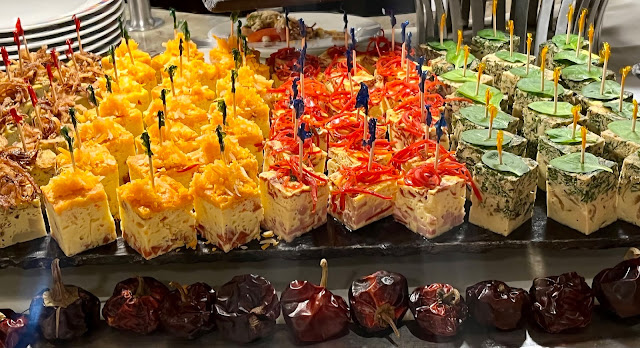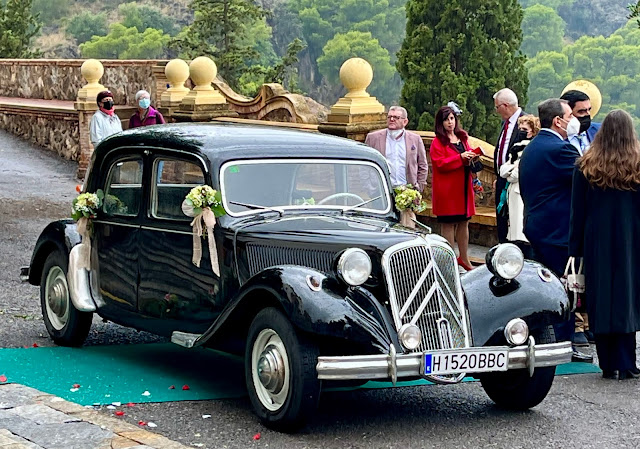Thursday, 25 November 2021
Thanksgiving Day at Sea
Yesterday's quiet day at sea ended as early evening lightning and thunderstorms put on an impressive show in the sky. I was enjoying the warmer weather and protection from the wind on my veranda when things started to blow up. The rain didn't last long, but the seas were a little turbulent during dinner (although we returned to smooth sailing before lights out), and I am glad that I had help carrying my dinner plate from the buffet to the table in the Terrace Cafe. The "Spanish Market" buffet on offer displayed a beautiful (and tasty) array of local dishes from southern Spain.
Saturday, 20 November 2021
Return to Cartagena
But as usual the blog returns to an earlier day as we sail into Cartagena's port, one of the most important in this part of the Mediterranean and home to the Spanish Navy.
I have been here twice before. First in late October 2016, while on board Holland America's brand-new Konigsdam, I fell as I was getting out of bed, broke my left hip, and spent 12 days here in hospital. Most of you are already bored by this story, but if you want more details, link back at the bottom of the page.
My second visit was in April 2017, just six months later. After a 14-day transatlantic cruise on Oceania from Miami to Barcelona, I spent a few days in Valencia and then took the train farther south to Cartagena. I hadn't had time for true goodbyes and thank yous when I was whisked away to the airport in Alicante in the early hours of the morning after my stay in the hospital. So I spent the night here and visited the hospital with a large bouquet of flowers and really surprised my surgeon (he recognized me by my Tucson cap and my quick little jig--they don't get many patients from Tucson), as well as the nurses on the ortho floor. I also had time for seeing the sights (check out the link below), before returning to Valencia.
So on today's visit to Cartagena, I take a shore excursion to the inland city of Murcia, provincial capital and largest city of the area. The weather is cloudy and dry as we drive the 50 minutes to Murcia, although there will be intermittent showers throughout the morning.
We drive through vast agricultural land, with vegetables and fruits growing that will be exported throughout the world. Although this is an arid area and like other parts of the world has suffered drought fora number of years, irrigation is supplied from a local river, a canal from Madrid (like the CAP system in Arizona), as well as desalinization plants in an emergency.
The first stop, just before reaching Murcia, is a visit to Fuensanta Sanctuary, a hilltop chapel dedicated to the Virgin. Today is Saturday, the busiest day of the week for weddings in Catholic Spain, and we witness the guests of one this morning. The small chapel has the usual baroque ornamentation (built 1694), and the wedding guests are all beautiful too.
As we enter the city of Murcia itself we cross the "old bridge" over the Segura River, containing a large sculpture of a sardine, a local catch and symbol of the city. At the end of Lent each year, when Catholics can eat meat again, there is a major celebration ending with the burning in effigy of a large papier-mâché sardine.
Our walking tour takes us from the gardens between the river and the City Hall (scene of secular weddings) to the Royal Casino (more of a municipal club than a gambling palace), which currently houses a remarkable series of rooms originally decorated in the early 20th century. The architecture combines modernist and eclectic styles.
The current building dates from the early 20th century. It was refurbished 2006-2009. The present building was reopened on 5 November 2009. Its beautiful rooms contain paintings and sculptures by local artists from the late 19th and early 20th centuries.
Our last guided visit is to the Cathedral, officially closed for reconstruction. But because today is Saturday--wedding day--our guide sneaks us in during a ceremony so that we may wander around very quietly.
Work on the foundations started in 1385 and the first stone was laid in 1388. The cathedral was not finished until October 1467. The building continued to evolve until the 18th century, demonstrating a variety of artistic styles: the interior is largely Gothic; the facade is Baroque (architect Jaume Bort i Meliá).
The bell tower, built between 1521 and 1791, stands 90 metres (300 ft) tall—95 metres (312 ft) with the weathervane. It is the tallest campanile in Spain. It ascends in five levels of different widths.


















__03.jpg)